Volume 31 · Number 3 · Summer 2014
Beyond the goal
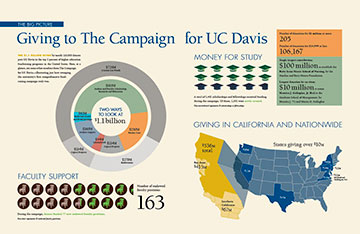
Illustration by Russ Thebaud/UC Davis
The Campaign for UC Davis is more than a success-against-all-odds story. It’s more than impressive numbers (though those are pretty cool too — see "Giving to The Campaign for UC Davis," right).
The goal-surpassing $1.1 billion effort, the first comprehensive fundraising campaign in the university’s history, is about an ever-expanding community of people connected to UC Davis.
That network extends across the university, up and down California and around the world — reflecting the geographic span of the nearly 110,000 donors who participated in the campaign as well as the global impact of the research and the prospective reach of the students that those donors support.
The campaign, publicly launched in October 2010 and officially concluded this May, exceeded the university’s goal of 100,000 donors and $1 billion in contributions — demonstrating, as Chancellor Linda P. B. Katehi said, “the enormity of what can be accomplished at UC Davis when we work together as one team.”
It would take an encyclopedia to detail all the ways in which the campaign has transformed UC Davis, so we highlight just a few here.
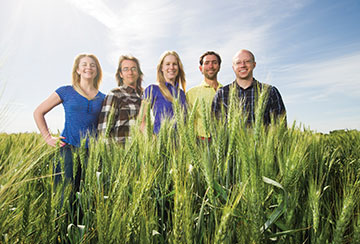
The brains behind your grains
The food on your plate tomorrow may depend on the research done today — in the lab and in the field — by graduate students Brittany Hazard, Joshua Hegarty, Rebecca Turner, Nicolás Cobo and Tyson Howell.
They study the genetics of wheat and other grains with Jorge Dubcovsky, a professor in the Department of Plant Sciences and a Howard Hughes Medical Institute–Gordon and Betty Moore Foundation investigator.
If you eat pasta, then you already benefit from research by Dubcovsky’s lab — and from the support it receives from the Howard Hughes Medical Institute–Gordon and Betty Moore Foundation Investigator Program.
Dubcovsky and colleagues are helping to boost the nutritional value of wheat, a grain that provides more than one-fifth of the calories consumed by people around the world. The researchers also develop wheat varieties that are more nutritious, disease- and frost-resistant, and better adapted for particular climates — a necessity for farmers confronted with a warming planet.
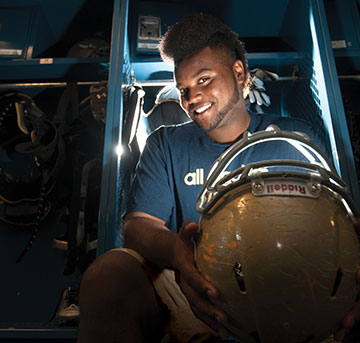
Marques Barron says he loves the camaraderie of the Aggie football team. “Everyone on the team cares for each other as brothers and would do anything for each other.”
Stretch for greatness
Darryl ’83 and Lois ’85 Goss believe that greatness comes from stretching to achieve excellence in all that you do — and having the right kind of support to stretch. Grateful to mentors who inspired them at UC Davis, they have worked to pay that support forward.
Student Marques Barron, in turn, said he is inspired by the Gosses’ example.
Barron, a fourth-year African American and African studies major from Merced and an Aggies defensive lineman, is the first recipient of the Joe Singleton Athletic Award. The scholarship, created by the Gosses with matching support from the UC Davis Foundation, is named in honor of the former coach and athletic director who was a mentor to Darryl.
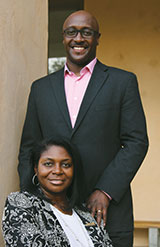
Darryl and Lois Goss
“The Goss scholarship is special to me because I strive to be as helpful and generous as the Gosses,” said Barron. “It has helped me be able to support myself, my daughter, and taken a load off my family, which is the most important thing in my life.”
The Singleton Award is among several undergraduate scholarships supported by the Gosses. Lois explained: “Student support is where our heart is.”
Darryl, who was recently named president of Sigma-Aldrich Corporation’s microelectronics manufacturing unit, said he experienced a life-defining moment as a student-athlete playing football under College Football Hall of Fame Coach Jim Sochor.
During one practice, Darryl stretched to make a catch. “Coach Sochor came over and said great players make the tough catch all the time. . . He was talking about the expectation of greatness. And that you do it all the time. Not just when it’s convenient.”
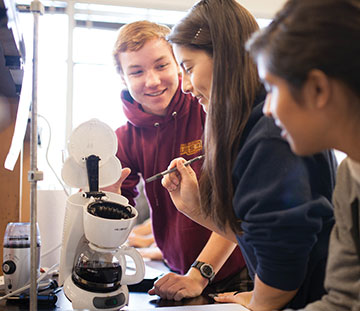
Brewing innovation
Students Westley Blacklock, Nadia Duenas and
Sunveer Bajwa work together to engineer the perfect cup of java in a new course, “Design of Coffee.” The course is one of two new class offerings that teach the principles of chemical engineering through the roasting, processing and brewing of coffee.
The popular courses—one is a general education class and the other is for engineering and materials science majors—were organized by professors Tonya Kuhl and Bill Ristenpart to give students more hands-on engineering labs sooner. Kuhl said, “A lot of people don’t really know what engineers do. But brewing coffee is tangible to everyone.”
A gift from John Wasson ’84, president and chief operating officer of ICF International, provided students with renovated and refitted lab space. Wasson, who majored in chemical engineering, believes in supporting these types of new courses that blend engineering, business, chemistry and other sciences.
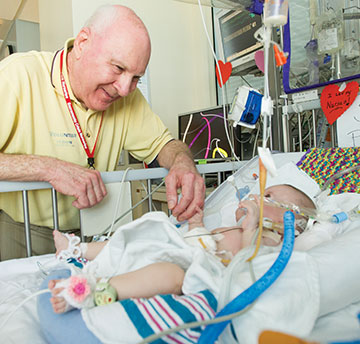
Jim Donoghue with a young patient
The power of human touch
Jim Donoghue, who never had children of his own, has volunteered countless hours for the last two years in the neonatal intensive care unit (NICU) at UC Davis Children’s Hospital, comforting the tiniest of patients.
Donoghue spends hours with premature babies, holding, rocking and patting them when their parents and nurses cannot.
“It’s so rewarding watching a child grow and develop,” Donoghue said, “and know that my care is helping make that happen.”
Because of his generous gift during The Campaign for UC Davis, his love for these premature babies will be felt for years to come — Donoghue has willed most of his estate to the NICU.
The UC Davis Children’s Hospital, which is a nationally ranked pediatric hospital with more than 120 physicians in 33 pediatric subspecialties, blends cutting-edge research with patient-focused team care in a nurturing environment because they know that healthy families are happy families.
Jacquelyn Kay-Mills, director of development for the Children’s Hospital, said: “Jim’s wonderful gift will help provide medical and other care for these special young patients coming into the world — and honors his selfless service to these babies.”
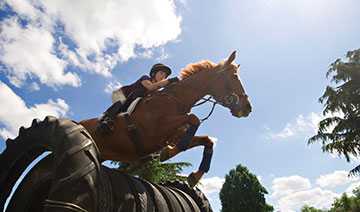
Leap of medical science
Healthy horse. Healthy rider. Both animals and people share a stake in the collaborative approach to medical research at UC Davis. The health of the environment rides on it too.
Racehorses that once would have been euthanized because of tendon and ligament injuries may now be given a second lease on life. Some dogs who have lost their jaws due to illness or injury can have them regrown. Wounded soldiers may one day repair their damaged bones with the help of stem cells from their own fat tissue.
Such breakthroughs in regenerative medicine illustrate some of the leaps of knowledge between veterinary and human medicine.
Similarly, the School of Veterinary Medicine’s One Health Institute addresses complex health problems around the world with the recognition that the health of domestic animals, wildlife and people are inextricably linked with each other and the environment.
This multidisciplinary and interconnected approach was supported by philanthropic gifts made during The Campaign for UC Davis.
For more, visit One Campaign, One Hundred Stories.
